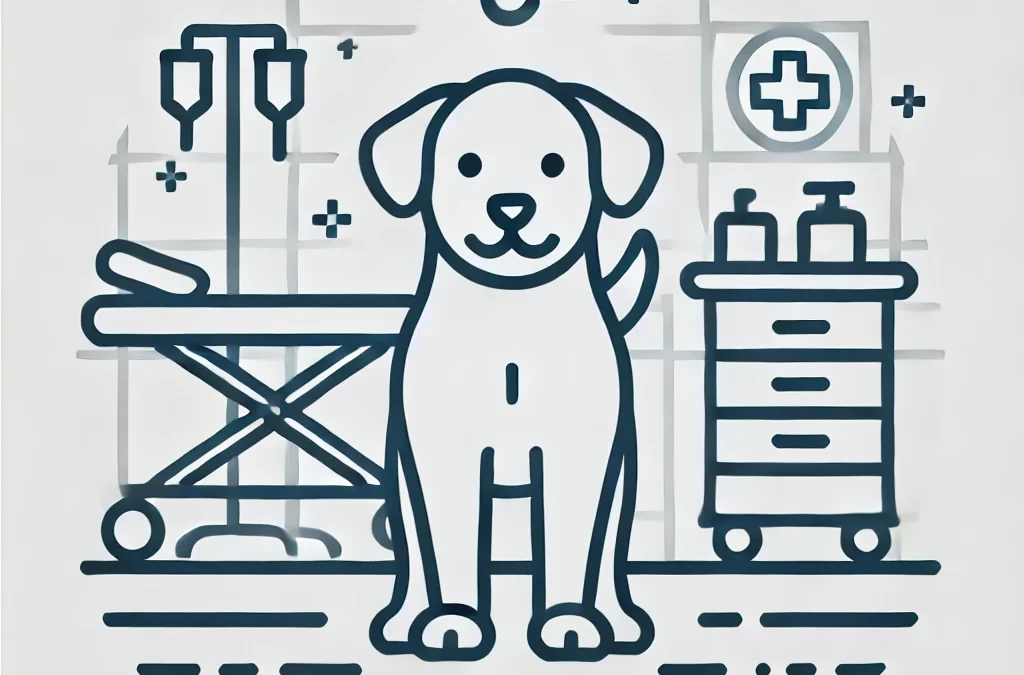
執筆者 TCMVET | 2024年11月20日 | 犬の癌と腫瘍
犬の伝染性性器腫瘍(TVT) は犬の癌の独特な形態で、主に直接接触することで感染します。通常は獣医の介入が必要ですが、医療を補完する在宅支持療法への関心が高まっています。この記事では、革新的で自然なホリスティックな実践が、自宅での TVT の管理に重要な役割を果たす方法を探り、獣医との連携の重要性を強調します。
TVT を理解する: 概要
TVT は、犬の外性器、口、または鼻に発生する伝染性の腫瘍です。一般的な症状は次のとおりです。
- 目に見える腫瘍の成長
- 出血または分泌物
- 患部の不快感や痛み
主な治療には、化学療法(通常はビンクリスチンを使用)、手術、放射線療法などがあります。ただし、これらの治療は、ペットの飼い主によっては必ずしも利用できる、または費用が手頃なわけではありません。このような場合に、在宅でのサポートケアが効果を発揮します。
TVT で犬の在宅ケアに革命を起こす
1. 免疫力を高める栄養
犬の免疫システムは、がんと闘う上で重要な役割を果たします。栄養価の高い食事を与えることで、犬の全体的な健康をサポートできます。次の点を考慮してください。
- 脂肪分の少ないタンパク質源: 筋肉量を維持するために七面鳥、鶏肉、魚を食べます。
- がん予防食品ブルーベリー、ニンジン、ブロッコリーには酸化ストレスと戦う抗酸化物質が含まれています。
- オメガ3脂肪酸: 魚油や亜麻仁油に含まれており、炎症を軽減するのに役立ちます。
プロのヒント: 腫瘍の成長を悪化させる可能性がある糖分や穀物を多く含む食品は避けてください。
2. 自然療法とハーブ
自然療法は TVT の症状を緩和し、管理するのに役立ちます。有望な選択肢としては次のようなものがあります。
- ターメリック(クルクミン): 抗炎症作用と抗腫瘍作用があることで知られています。
- チュアンシオン(四川ラビジン): 血行を改善し、治癒を促進すると信じられている伝統的な中国のハーブ。
- CBDオイル: 炎症を軽減し、痛みを管理し、全体的な快適さを向上させるのに役立ちます。
重要: 安全な投与量を決定するには必ず獣医に相談してください。
3. ストレスのない環境を作る
ストレスは犬の免疫システムを弱める可能性があります。次の方法で、ペットが穏やかで快適な環境にいるようにしてください。
- 家庭内の騒音から離れた静かな休憩スペースを提供します。
- ラベンダーエッセンシャルオイルディフューザーなどの心を落ち着かせるものを使用する(換気の良い部屋で)。
- 活動的で幸せな状態を保つために、軽くてストレスの少ない活動に従事します。
4. 創傷および腫瘍のケア
外部に腫瘍がある場合は、出血したり感染したりする可能性があります。自宅でのケアには以下が含まれます。
- 感染を防ぐために、患部を生理食塩水で優しく洗浄します。
- 獣医承認の軟膏を使用して治癒を促進します。
- 赤み、腫れ、悪臭などの感染の兆候を監視します。
5. 腸の健康を強化する
TVT 治療を受けている犬は、消化器系の問題を抱えていることがよくあります。プロバイオティクスとプレバイオティクスは、腸の健康を改善し、栄養素の吸収を高めることができます。ヨーグルト (無糖) または獣医用プロバイオティクス サプリメントを食事に加えることができます。
6. 代替療法
- 指圧とマッサージ: 血行を改善し、痛みを軽減するのに役立ちます。
- Homeopathy: 次のような治療法 アルセニカムアルバム または トゥジャ がん治療のサポートに使用されることもあります(獣医の指導の下で)。
在宅治療でできること、できないこと
これらのアプローチは犬の快適さと全体的な健康を向上させることができますが、 専門的な医療に代わるものではないTVT は深刻な病気で、治癒には化学療法やその他の獣医治療が必要になることがよくあります。自宅でのケアは、犬の生活の質を向上させ、回復をサポートするための補完的なアプローチとして使用するのが最適です。
全体的アプローチが鍵
自宅で TVT を治療するというのは、奇跡的な治療法を見つけることではなく、犬が養われ、支えられていると感じられる環境を作ることです。獣医による治療と革新的な在宅ケアの実践を組み合わせることで、愛犬が回復する可能性を最大限に高めることができます。
最終的な考え
自宅で TVT を管理するには、献身、創造性、獣医専門家との協力が必要です。病気を治療するだけでなく、犬の人生に希望、健康、幸福を取り戻すことが目的です。この総合的なアプローチにより、飼い主は犬の治癒過程に積極的に関与し、犬が当然受けるに値する愛情とケアを確実に受けられるようにすることができます。

執筆者 TCMVET | 2024年11月18日 | 犬の癌と腫瘍
犬の白血病は「静かな病気」と呼ばれることがよくあります。症状が表面化する頃には、病気がすでに進行している可能性があります。しかし、この隠れた敵が大きな音を立てて襲いかかる前に、そのかすかなささやきに耳を傾けることができたらどうでしょうか。犬の白血病の初期兆候に気づけば、犬の命が救われるだけでなく、生活の質も大幅に向上します。臨床的洞察と犬のケアに対する総合的なアプローチを融合させ、これらの早期警告信号の型破りな探究に乗り出しましょう。
微妙なヒントを解読する
白血病は、他のそれほど深刻ではない病気によく似せられます。早期発見には、鋭い観察力と犬の行動に対する直感的な理解が必要です。以下に、注意すべき目立たない兆候を挙げます。
- 異常な疲労感または無気力 いつもは元気な子犬が、突然、遊ぶよりものんびり過ごすことを好むようになります。この無気力は、単に老化や大変な一日のせいではありません。何かもっと深刻な問題があるかもしれないという身体からのシグナルなのです。
- 歯茎と舌が青白くなっている 健康な歯茎は、風船ガムのようなピンク色です。犬の歯茎や舌が青白く見える場合は、赤血球の生成低下によって引き起こされる白血病の一般的な初期症状である貧血の可能性があります。
- 持続性または原因不明の感染症 治療に反応しない頻繁な感染症は、免疫システムが弱まっていることを示している可能性があります。白血病は白血球の機能を低下させ、犬を細菌、真菌、またはウイルスの侵入に対して脆弱にします。
- リンパ節の腫れ 特に首、肩、後ろ足の周りのリンパ節が腫れているのは、何かがおかしいという明らかな兆候です。白血病に限ったことではありませんが、調べる価値のある兆候です。
- Unexplained Weight Loss 白血病にかかった犬は、食欲は維持しているにもかかわらず、体重が減ることがあります。これは、病気が体の資源を奪い、筋肉の衰弱とエネルギーの枯渇を引き起こすために起こります。
- 打撲や出血 皮膚の下の小さな赤または紫色の点(点状出血)や原因不明のあざに注意してください。白血病は血小板の生成を妨げ、凝固の問題を引き起こします。
- 食欲不振または嘔吐 これらの症状は多くの病気に共通していますが、症状が持続する場合は白血病などの根本的な問題を示している可能性があります。
早期発見が重要な理由
白血病は早期発見すればするほど、治療結果は良くなります。多くの犬の飼い主は、特に高齢の犬の場合、時々無気力になったり食欲がなくなったりするのは普通だと考えていますが、これらの兆候を無視すると、適切なタイミングで介入する機会を逃すことになります。定期的な血液検査は、白血病が進行する前に発見するためのシンプルですが強力な手段です。
臨床を超えて:感情的なつながり
犬は痛みを隠すのが得意です。家族との交流を断ったり、様子がおかしいように見せたりする行動の変化は、苦痛の初期の感情的なサインであることが多いです。ペットとの深い絆を築くことで、こうした微妙な変化に気づくことができます。
犬の白血病に関する総合的な視点
化学療法やステロイドなどの従来の治療法が一般的ですが、ホリスティックケアを組み込むことで犬の生活の質を高めることができます。以下にいくつかの選択肢を示します。
- 栄養サポート
- 免疫力を高めるには、ブルーベリーやほうれん草など抗酸化物質が豊富な食品を摂取しましょう。
- 骨スープは必須栄養素を提供し、食欲を維持するのに役立ちます。
- 天然サプリメント
- ターメリック: 抗炎症作用により、全体的な健康をサポートします。
- 霊芝キノコ免疫力を高め、抗がん作用があることで知られています。
- ストレスマネジメント
- 犬に安全なラベンダーなどのオイルを使った優しいマッサージやアロマセラピーは、症状を悪化させる可能性のあるストレスを軽減することができます。
- ハーブ療法
- 伝統的な中国医学のハーブ レンゲ そして ダンシェン 免疫力とエネルギーレベルをサポートする可能性があります。
予防策:先手を打つことはできるのか?
白血病は必ずしも予防できるわけではありませんが、特定の行動によってリスク要因を低下させることができる可能性があります。
- 定期的な獣医検査: 毎年の血液検査により異常を早期に発見できます。
- 毒素への曝露を制限する: ペットの周りでの殺虫剤、除草剤、喫煙は避けてください。
- 健康的な食生活を維持する: バランスのとれた栄養豊富な食事は犬の免疫システムを強固に保ちます。
いつ行動するか
愛犬がこれらの初期症状を複数示している場合は、待たずにすぐに獣医に相談してください。簡単な血液検査で原因がわかり、白血病と診断された場合は早期介入により愛犬の寿命を大幅に延ばすことができます。
希望の光
白血病は必ずしも死を意味するものではありません。獣医学の進歩、総合的なサポート、飼い主の揺るぎない愛情があれば、白血病と診断された犬も充実した生活を送ることができます。鍵となるのは、警戒、教育、そして積極的な対策です。
結論
犬の白血病の初期症状は風にささやくようなもので、見落としがちですが、聞くことは重要です。犬の身体的および感情的な合図に注意を払っていれば、この隠れた敵が根付く前に阻止することができます。結局のところ、私たちの4本足の仲間は、必要なときに最善を尽くすに値します。

執筆者 TCMVET | 2024年11月18日 | 食と健康
ペットにとって、関節の健康を保つことは基本的なニーズを満たすことと同じくらい重要です。関節サプリメントは単なる予防ケアではありません。ペットにとってより長く幸せな生活への架け橋なのです。しかし、 最高 ペットの関節サプリメント? 常識を破り、関節の健康を再定義する型破りでありながら効果的なソリューションを探ってみましょう。
関節ケアの再考:グルコサミンだけの問題ではない
長年、グルコサミンとコンドロイチンはペットサプリメント業界を席巻してきました。これらは効果的ですが、これらの成分だけに頼ると、他の革新的な解決策を見落としてしまう可能性があります。現代の関節サプリメントには、以下の成分が組み込まれています。
- オメガ3脂肪酸: 抗炎症作用があることで知られており、関節の可動性を大幅に改善します。オメガ 3 の強力な供給源である緑イ貝の抽出物を含むサプリメントを探しましょう。
- ウコンとクルクミンこれらの天然成分は、炎症を軽減し、軟骨の破壊を遅らせる強力な抗酸化物質として注目を集めています。
- ヒアルロン酸スキンケアと関連付けられることが多いこの成分は、関節の潤滑を改善し、よりスムーズな動きを保証するために、現在ペットのサプリメントにも使用されています。
ペットのライフスタイルに合わせた関節ケア
ペットは 2 匹として同じものはありません。関節の健康に対するニーズは、品種、年齢、活動レベル、さらには食事によって異なります。万能のアプローチではなく、次のようなカスタマイズされたソリューションを検討してください。
- シニアペット向け: 軟骨の修復をサポートし、可動性を向上させるために、コラーゲンと MSM (メチルサルフォニルメタン) が強化されたサプリメントを選択してください。
- 活動的な犬種向け: 伝統医学で使用されているハーブであるボスウェリアセラータなど、筋肉の回復と関節のクッションに重点を置いた成分を探してください。
- 小型犬用: 便利に食事に混ぜられる、小さくて噛みやすい形状や液体のサプリメントを選びましょう。
ホリスティックな関節の健康: サプリメントを超えて
最適な関節サプリメントは方程式の一部に過ぎません。関節の健康をサポートするには、総合的なアプローチが必要です。
- 体重管理: 過剰な体重は関節に不必要な負担をかけます。バランスの取れた食事と適切なサプリメントを摂取することで、ペットの理想的な体重を維持できます。
- 低衝撃運動水泳や適度なウォーキングなどの活動は、過度の負担をかけずに関節の柔軟性を維持するのに役立ちます。
- 定期的な獣医検査: 獣医師と一緒にペットの関節の健康状態を監視することで、問題を早期に発見し、ケアプランを調整することができます。
革新的なフォーマット: ペットに優しいサプリメントの実現
ペットに錠剤を飲ませる時代は終わりました。現在、最高のサプリメントは次のようになります。
- おいしいおやつ: ペットがおやつと間違えるフレーバーオプション。
- パウダーフォーミュラ: 食事に簡単に混ぜられるので、好き嫌いの多い方にも最適です。
- オイルドロップ: 歯に問題のあるペットや固形物が苦手なペットにも便利です。
関節の健康を自分で作る: サプリメントを自分で作れますか?
ペットの世話に携わる飼い主なら、自家製サプリメントを作るのも選択肢の 1 つです。骨のスープはグルコサミンとコンドロイチンの優れた天然源です。ターメリック ペースト (ココナッツ オイルと黒コショウで吸収力を高めたもの) と組み合わせると、強力な抗炎症剤が完成します。
ただし、DIY ソリューションに取り組む前に獣医師に相談し、適切な投与量とペットの食事との適合性を確認してください。
ユニークな食材に注目
ペットサプリメント業界では、次のような独自の科学的根拠に基づいた成分が増加しています。
- アスタキサンチン: 酸化ストレスを軽減し、関節の回復を促進する強力な抗酸化物質です。
- 卵殻膜: コラーゲン、グルコサミン、ヒアルロン酸の天然源で、軟骨の修復と関節全体の健康をサポートします。
- シッスス・クアドラングラリス: あまり知られていないハーブですが、伝統的に骨を癒し、関節の痛みを軽減するために使用されています。
適切なサプリメントの選び方
関節サプリメントを購入するときは、以下の点に留意してください。
- 透明性すべての成分とその投与量を開示しているブランドを探してください。
- Third-Party Testing: 製品の安全性と有効性がテストされていることを確認してください。
- 獣医承認獣医師が推奨するサプリメントには、臨床的な裏付けがあることが多いです。
結論: より良い健康のための共同の取り組み
最高のペット用関節サプリメントは単なる製品ではありません。ペットの健康を守るためのライフスタイルの一部なのです。革新的な原料を採用し、ペットのニーズに合わせたケアを行い、総合的なアプローチを採用することで、ペットがジャンプしたり、走ったり、尻尾を振ったりするのを最大限楽しむことができます。
関節の健康への道のりは、平凡なものである必要はないことを覚えておいてください。おやつ袋の外側を考え、ペットに本当に必要なケアを与える時が来ました。

執筆者 TCMVET | 2024年11月16日 | 犬の癌と腫瘍
「腫瘍」という言葉を聞くと、私たちはたいてい最悪のシナリオである癌を思い浮かべます。しかし、すべての腫瘍が悪性というわけではありません。実際、犬の良性腸腫瘍はそれほど悪性ではなく、適切なアプローチで効果的に管理できる場合が多いのです。この記事では、これらの良性腫瘍のニュアンスを詳しく調べ、その原因、症状、管理戦略を理解するのに役立ちます。
良性腸腫瘍とは何ですか?
良性の腸腫瘍は、犬の消化管に発生する非癌性の腫瘍です。腫瘍は周囲の組織を侵したり、体の他の部分に広がったりすることはありませんが、腫瘍が大きくなって腸を塞いだり、正常な機能を妨げたりすると、不快感や消化器系の問題を引き起こす可能性があります。
犬によく見られる良性腸腫瘍の種類:
- 腺腫: 腸の内壁の腺細胞から発生します。
- 平滑筋腫腸壁の平滑筋細胞に由来します。
- ポリープ腸の内壁から突出する小さな腫瘍。
原因: なぜこれらの腫瘍が発生するのでしょうか?
犬の良性腸腫瘍の正確な原因は不明ですが、いくつかの要因が関係している可能性があります。
- Genetics: ジャーマンシェパードやコリーなどの一部の犬種には、素因がある可能性があります。
- Chronic Inflammation: 長期にわたる消化管の炎症は異常な細胞増殖のリスクを高める可能性があります。
- 食事要因: 繊維質の少ない質の悪い食事はポリープの発達に影響を与える可能性があります。
症状: 注目すべき点
良性腫瘍はゆっくりと成長することが多く、最初は症状がわかりにくいものです。時間が経つにつれて腫瘍が大きくなると、次のような兆候が現れることがあります。
- 慢性的な嘔吐または下痢: 刺激または部分的な閉塞によるもの。
- 減量: 腫瘍が栄養吸収に影響を与える場合。
- 便に血が混じる: 腫瘍の位置に応じて明るい赤色または暗い色になります。
- Abdominal Pain: 腫瘍により腹部膨満や閉塞が生じる場合。
- 食欲の変化: 空腹感と食事拒否の間の変動。
レッドフラッグ: 持続的な消化管症状がある場合は、獣医師の診察を受けて徹底的な評価を受ける必要があります。
診断: 問題の特定
良性腸腫瘍の診断には、次のような複数の技術の組み合わせが必要です。
- 身体検査腹部を触診して腫瘤の有無を確認します。
- イメージング: 腸管を視覚化するためのX線または超音波検査。
- 内視鏡検査: 腫瘍を観察し、場合によっては生検を行うためのカメラ補助検査。
- 生検確定診断は、腫瘍が良性かどうかを判断するために組織サンプルを分析することによって行われます。
治療:良性腫瘍の管理の選択肢
良性腫瘍は生命を脅かすものではありませんが、症状を緩和したり合併症を予防したりするために治療が必要になることがよくあります。
1. 外科的除去
- いつ手術が必要ですか? 腫瘍が閉塞や重篤な症状を引き起こす場合。
- 結果: 良性腫瘍の場合は通常手術で治癒し、犬は手術後に順調に回復します。
2. 内視鏡的ポリープ切除術
- それは何ですか? 内視鏡を使用してポリープや小さな腫瘍を除去する、侵襲性の低い方法。
- 利点: 回復時間が短く、不快感も最小限に抑えられます。
3. 食生活の調整
- なぜ役立つのか: 繊維質の多い食事は炎症を軽減し、治療後の腸の治癒をサポートする可能性があります。
- 摂取すべき食品: カボチャ、調理したサツマイモ、獣医推奨のドッグフード。
4. 監視
- 小さな腫瘍の場合: すぐに介入することなく成長を監視するための定期的な検査。
予後: 何を期待するか
良性の腸腫瘍は、適切に治療すれば、一般的に予後は良好です。腫瘍が再発したり、さらなる問題を引き起こしたりしないようにするには、定期的な獣医の診察と経過観察が不可欠です。
予防:リスクを下げることはできますか?
予防を保証することは不可能ですが、以下の手順を実行することで、犬の良性腸腫瘍を発症するリスクを軽減できる可能性があります。
- バランスの取れた食事: 高品質のタンパク質、健康的な脂肪、十分な繊維を摂取します。
- 定期的な獣医の診察定期的な検査により、潜在的な問題を早期に発見できます。
- 症状に注意する早期発見により、よりシンプルで侵襲性の低い治療が可能になります。
ユニークな視点:腸と全体的な健康
興味深いことに、犬の腸の健康は犬の全体的な健康状態に密接に関係しています。良性の腫瘍が存在する場合、炎症や不適切な食事など、根本的な不均衡の兆候である可能性があり、注意が必要です。腫瘍の治療は治療の過程の一部に過ぎません。根本的な原因に対処することで、犬の健康と活力を維持できます。
結論: 課題をチャンスに変える
犬の良性腸腫瘍は心配ではありますが、管理可能で、治癒可能な場合が多いです。腸の健康を最優先にし、栄養のある食事を与え、獣医師との強力なパートナーシップを維持することを思い出させてくれます。注意と警戒があれば、あなたの愛犬は幸せで快適な生活を続けることができます。

執筆者 TCMVET | 2024年11月16日 | 犬の癌と腫瘍
リンパ腫は犬に最も多く見られる癌の 1 つであり、飼い主にとって悲惨な事態となることもありますが、快適さと生活の質を提供することが最も重要です。現代の獣医ケアと総合的なアプローチを組み合わせることで、この困難な旅の間中、犬が愛され、安全で、快適に過ごせるようにすることができます。これを実現する方法について、新たな視点でご紹介します。
1. パーソナライズされた栄養: 心地よさのための食事
リンパ腫を患う犬は、食欲や消化に問題を抱えることがよくあります。食事を調整する方法は次のとおりです。
- 抗炎症食品: 炎症を抑えるために、魚油に含まれるオメガ 3 脂肪酸を摂取しましょう。ほうれん草やサツマイモなどの新鮮で軽く調理した野菜も免疫力を高めます。
- おいしい選択肢: 温かい骨スープやヤギのミルクを使用すると、食事の食欲をそそり、消化しやすくなります。
- 炭水化物の過剰摂取を避ける: がん細胞は糖分を栄養源として増殖するため、高血糖食品の摂取を減らし、赤身のタンパク質と健康的な脂肪を摂取するようにしましょう。
2. 安らぎの環境を作る
静かで居心地の良い空間は、犬のストレスを軽減し、全体的な健康状態を改善するのに役立ちます。
- 整形外科用寝具: 関節の痛みや不快感を和らげるために、柔らかくサポート力のあるベッドを提供します。
- 温度制御特に温度に敏感な場合は、快適に過ごせるよう、必要に応じて加熱パッドや冷却マットを使用してください。
- 心地よい音: 穏やかな音楽やホワイトノイズは、特に落ち着きがなかったり不安そうに見えたりする場合には、穏やかな環境を作り出すのに役立ちます。
3. 症状緩和のための自然療法
ホリスティック療法は伝統的な治療法を補完する優れた治療法です。
- CBDオイル: 抗炎症作用と鎮痛作用があることで知られる CBD オイルは、痛みを軽減し、食欲を増進するのに役立ちます。
- ハーブサプリメント: ウコン(炎症に)や黄耆(免疫サポートに)などのハーブは有益ですが、与える前に獣医に相談してください。
- 指圧とマッサージこれらのテクニックは、緊張を和らげ、血行を改善し、心を落ち着かせる効果をもたらします。
4. 適度な運動と精神刺激
激しい運動は避けるべきですが、軽い運動と精神的な関与は、感情的および身体的健康にとって重要です。
- 短い散歩: 過度の運動を避けるために、犬のペースに合わせて短くしてください。
- インタラクティブ玩具パズルフィーダーやスナッフルマットは、犬のエネルギーを節約しながら、精神的に刺激を与えることができます。
- 優しい遊び: ぬいぐるみの引っ張り合いや、優しくボールを投げて取る遊びなどの簡単なゲームは、疲れさせることなく喜びをもたらします。
5. 獣医師とのオープンなコミュニケーション
犬の快適さを確保するには、獣医師との協力が不可欠です。
- 疼痛管理定期的に痛みのレベルを評価し、必要に応じて薬を調整します。
- 緩和ケア計画: リンパ腫の症状を軽減するのに役立つコルチコステロイドなどの緩和療法の選択肢について獣医に相談してください。
- 頻繁な監視: 行動、食欲、エネルギーの変化を追跡し、問題に迅速に対処します。
6. 感情的なサポート:愛の癒しの力
あなたの存在と気遣いがあなたの犬にとって最大の安心の源です。
- 一貫したルーチン犬は予測可能なスケジュールに安心感を覚えるので、定期的な食事、散歩、休憩時間を維持してください。
- 優しいやりとり: 優しく話しかけ、たっぷり抱きしめてあげ、休みたいときには彼らの合図を尊重してください。
- 大切な瞬間: 太陽の下で寝転んだり、ゆっくりと車に乗ったりするなど、犬が大好きなアクティビティをして、有意義な思い出を作りましょう。
7. 次のステップに備える
リンパ腫が進行するにつれて、生活の質に重点を置くことが重要になります。
- 生活の質の評価HHHHHMM スケール (痛み、空腹、水分補給、衛生、幸福、移動、悪い日よりも良い日が多い) などのツールは、ペットのケアに関する決定を下すのに役立ちます。
- 終末期の計画: 愛犬の最後の日々が穏やかで苦痛のないものとなるよう、ペットホスピス サービスに相談することを検討してください。
結論:思いやりの旅
リンパ腫に苦しむ犬を助けることは、症状を管理することだけではありません。一緒に過ごすすべての瞬間を大切にすることです。思いやりのある獣医のケアとホリスティック療法、そしてたっぷりの愛情を組み合わせることで、犬にふさわしい安らぎと尊厳を与えることができます。覚えておいてください。あなたの犬はリンパ腫と闘っているかもしれませんが、あなたの揺るぎないサポートと愛情は常に犬に与えられます。





